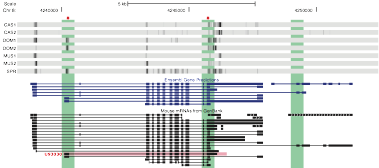Bettina Harr, PhD
2017
The goal of our research is to connect phenotypic change during speciation with the underlying genetics. We do this using a “bottom up” approach, first studying the genetic differences between closely related species and then attempting to relate these to speciation. For example two old and prominent theories to explain the origin of new adaptations emphasize the importance of gene duplications and changes in gene regulation. Over the past ten years the techniques have become available to test these theories at the molecular level. Whole genomes have been sequenced, and changes in gene regulation can be assessed using various whole-genome techniques. We use these methods plus computer based analysis to study evolution in the house mouse (Mus musculus) complex. Among those species that have an advanced resource base, including the complete genome sequence, the house mouse is probably the best to study divergence at the species level. It contains 3-4 subspecies that meet in natural hybrid zones, and the outgroup is not genetically distant. Colonization of human habitats has resulted in widespread dispersal across the world, and this has likely been associated with adaptive changes. The house mouse is thus a model system for studying genetic changes associated with adaptation and speciation.
We study speciation in the house mouse on 2 levels:
-
a)directly in the hybrid zone
We use whole-genome genotype analysis, phenotype analysis, gene expression screens and introgression analysis to directly identify genes that contribute to reduced hybrid fitness in the hybrid zone, employing techniques such as Genome-wide association studies and admixture mapping.
b) comparative genomics of extant house mouse subspecies
A recent example includes the systematic assessment, using Illumina Sequencing and detailed gene by gene experiments, of the contribution of alternative splicing to subspecies differentiation, and its potential role in speciation. Our work showed that structural differences in transcripts contribute to early transcriptome divergence among house mouse subspecies.
We have also recently started a collaborative project with Trevor Price, which aims at building reference genomes for 2 subspecies of the greenish warbler, using Nanopore long read sequencing.

Research

location Max-Planck-Institute for Evolutionary Biology, 24304 Ploen, Germany
&&
Department for Ecology and Evolution, University of Chicago, Chicago, USA
job Research Scientist
subjects evolutionary genetics, speciation, genomics



